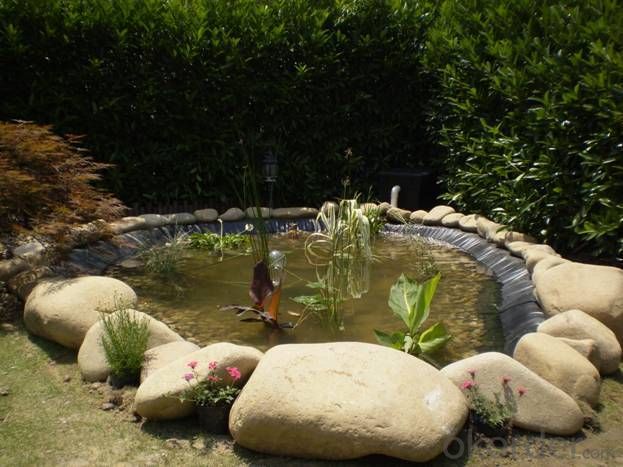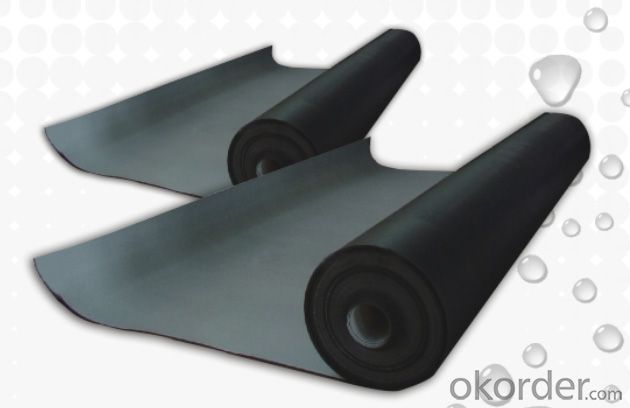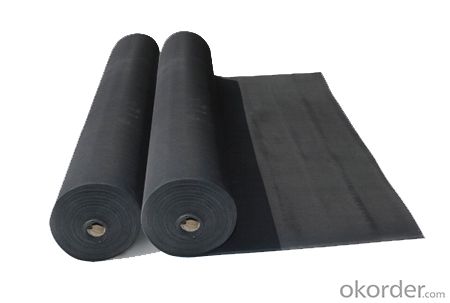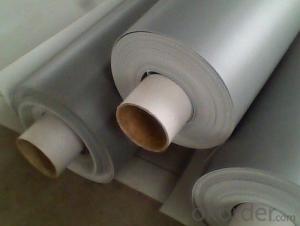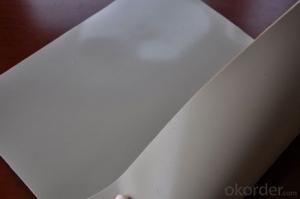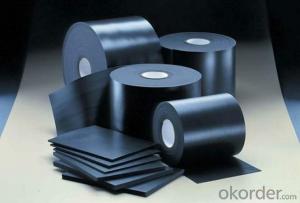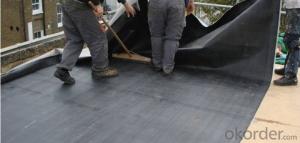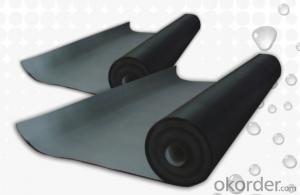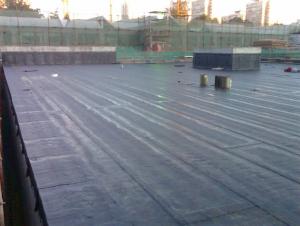EPDM Rubber Coiled Waterproof Membrane for Roof Top
- Loading Port:
- Shanghai
- Payment Terms:
- TT OR LC
- Min Order Qty:
- 50000 m²
- Supply Capability:
- 5000000 m²/month
OKorder Service Pledge
OKorder Financial Service
You Might Also Like
EPDM Rubber Coiled Waterproof Membrane for Roof Top
Description Of EPDM Rubber Coiled Waterproof Membrane for Roof Top:
•EPDM waterproof sheet has excellent anti-ozone-aging performance, able to resist ultraviolet light and corrosion of many chemical corrosive materials in the atmosphere
•It has high tensile strength, high ductility and strong retractility, it has excellent crack resistance, able to effect waterproof function even with tiny vibration of buildings.
• Excellent resistance to ozone, oxidation and sunlight.
• Resistance to chemicals; resistant to most inorganic products.
Main Features of EPDM Rubber Coiled Waterproof Membrane for Roof Top:
1>Excellent antiaging performance, service life up to 50 years
2>Working well with in 40C to 100C,it canbe constructed with a single layer in ambient temperature.
3>Waterproofing on various kinds of underground project,industrial of civil buildings and structures.
4>high extension rate, high tensile strength, small size changes at heat treatment
5>Good plant roots penetrability resistance and can be made waterproofing layer of planting roof
6>Special modified molecular structure ,effectively resolving the current domestic and foreign glue joint problem.
7>Good low temperature flexibility, and good performance of adapting to ambient temperature changes.
8>Convenient application ,solid joint, no environment pollution
9>chemical corrosion Resistance, can be used for special occasions
10>Convenient maitenance, low cost.
Specifications of EPDM Rubber Coiled Waterproof Membrane for Roof Top:
| Material | EPDM Rubber |
| Size | 1.2m (width)*20m (length) or customized, weldable type 2.05m or 4m width |
| Thick | 1.2mm, 1.5mm, 2.0mm |
| Type | Vulcanized & Weldable |
| Pattern | Non-reinforced (homogeneous) |
| Certificate | ISO9001/14001 |
Applications of EPDM Rubber Coiled Waterproof Membrane for Roof Top:
Widely used in roofs, basement, toilet ,swimming pool, and all kinds of industry and civil building waterproofing, reservoir, vivicism, bridge, underground, tunnel and dam waterproofing ,especially to the keystone waterproofing projects which is durability, high corrosion resistance and easy deformation.



IMages of EPDM Rubber Coiled Waterproof Membrane for Roof Top:




FAQ of EPDM Rubber Coiled Waterproof Membrane for Roof Top:
1. What are we supplying?
We are specialized in producing Colorful Asphalt Roof Shingle, SBS/APP modified bitumen waterproof membrane, Self adhesive bitumen waterproof membrane, PVC waterproofing membrane, EPDM rubber roofing membrane, Single Component Polyurethane Waterproof Coating, and Spray Polyurea Waterproof Coating
.
2. How Many years experience do we have?
We have been exported to more than 20 countries in the past 15 years.
3. How long do we usually reply your request?
We always reply our customer within 24 hours.
- Q: How does a waterproofing membrane handle temperature fluctuations?
- A waterproofing membrane is designed to handle temperature fluctuations by being able to expand and contract without compromising its effectiveness. It is made of materials that are flexible and can withstand extreme temperatures, ensuring that it remains intact and continues to provide protection against water infiltration.
- Q: What is the difference between SBS and APP rolls?
- Compared to the use of SBS waterproofing membrane to use a larger range. But each has its own advantages and disadvantages, according to the local environment and the actual situation of the building in combination with the characteristics of two kinds of coil to choose materials. You have to compare the next, I can only tell you SBS waterproofing membrane prices than APP waterproofing membrane high.
- Q: Can a waterproofing membrane be used on roofs or only on vertical surfaces?
- A waterproofing membrane can be used on both roofs and vertical surfaces. It is a versatile solution that can effectively protect a variety of structures from water damage, including roofs, walls, and foundations.
- Q: Can a waterproofing membrane be used in areas with high levels of moisture and humidity?
- Yes, a waterproofing membrane can be used in areas with high levels of moisture and humidity. Waterproofing membranes are specifically designed to prevent water penetration and can effectively protect surfaces from water damage even in damp and humid environments.
- Q: Can a waterproofing membrane be applied over existing waterproofing layers?
- Yes, a waterproofing membrane can be applied over existing waterproofing layers. However, it is important to assess the condition of the existing layers to ensure they are sound and can provide a proper substrate for the new membrane. Additionally, proper surface preparation and compatibility between the existing layers and the new membrane should be considered to ensure a successful and long-lasting waterproofing system.
- Q: How does a waterproofing membrane handle hydrostatic pressure?
- Hydrostatic pressure is managed by a waterproofing membrane, which acts as a barrier between water and the structure it is applied to. When faced with hydrostatic pressure, the membrane creates a seamless seal that stops water from entering the structure. The membrane is constructed to be impermeable, meaning it does not allow water molecules to pass through. Typically made from rubber, PVC, or bitumen, these materials have excellent resistance to water penetration. They are also flexible, enabling the membrane to conform to the surface it is applied to and create a secure seal. When the membrane experiences hydrostatic pressure, it withstands the force and prevents water from infiltrating the structure. The membrane's ability to resist water pressure depends on its thickness, strength, and installation quality. Thicker membranes offer greater resistance to hydrostatic pressure, while a well-installed membrane without gaps or overlaps enhances its effectiveness in managing water pressure. In addition to acting as a barrier against water penetration, some waterproofing membranes are designed to accommodate movement caused by hydrostatic pressure. They can stretch or elongate to accommodate the structure's expansion and contraction, which occurs due to varying water levels or external forces. This flexibility helps the membrane maintain its integrity and prevent water from seeping through. Overall, a waterproofing membrane effectively handles hydrostatic pressure by providing a continuous, impermeable barrier that resists the force of standing or moving water and prevents it from infiltrating the structure. Its ability to withstand water pressure depends on its thickness, strength, installation quality, and flexibility to accommodate movement.
- Q: Can a waterproofing membrane be used for data centers?
- Yes, a waterproofing membrane can be used for data centers. Waterproofing membranes are commonly used in construction to prevent water intrusion and leakage. In data centers, where protection against water damage is crucial for sensitive equipment and infrastructure, a waterproofing membrane can provide an additional layer of protection to safeguard against potential water leaks or flooding.
- Q: Can a waterproofing membrane be used on stadium seating areas?
- Indeed, stadium seating areas can benefit from the application of a waterproofing membrane. Typically utilized to shield structures from water-related harm, such as roofs, basements, and decks, waterproofing membranes prove invaluable. Stadium seating areas, being frequently exposed to the elements like rain and snow, are susceptible to water damage if not adequately safeguarded. The implementation of a waterproofing membrane effectively thwarts water infiltration, thereby averting potential predicaments including mold proliferation, material deterioration, and structural impairment. It is crucial to select a top-notch waterproofing membrane specifically formulated for outdoor usage, capable of enduring heavy foot traffic, thus guaranteeing enduring protection for the stadium seating areas.
- Q: Can a waterproofing membrane be used for planter boxes and green roofs?
- To ensure the longevity and functionality of planter boxes and green roofs, it is highly recommended to use a waterproofing membrane. This membrane acts as a barrier, preventing water from causing damage to the underlying structures. For planter boxes, a waterproofing membrane is crucial in order to prevent water leakage and protect the surrounding structures. Additionally, it aids in retaining moisture within the planter box, ensuring adequate hydration for the plants. Similarly, green roofs require a waterproofing membrane to prevent water from infiltrating the roof structure and causing leaks or structural damage. This membrane acts as a protective layer, facilitating proper drainage and preventing water accumulation on the roof surface. When choosing a waterproofing membrane for planter boxes and green roofs, durability, flexibility, and resistance to root penetration should be taken into consideration. Some membranes are specifically designed for these applications and offer additional features such as root barriers to prevent damage caused by plant roots penetrating the membrane. In conclusion, a waterproofing membrane is an indispensable component for planter boxes and green roofs. It serves to prevent water leakage, retain moisture, and safeguard the underlying structures from potential damage caused by water infiltration.
- Q: Can a waterproofing membrane be used for chemical storage facilities?
- Yes, a waterproofing membrane can be used for chemical storage facilities. Waterproofing membranes are designed to create a barrier against water and moisture, and they can also provide protection against chemical spills and leaks. These membranes are typically made from durable materials such as PVC or EPDM, which have excellent resistance to various chemicals. Additionally, waterproofing membranes can be applied to various surfaces including concrete, metal, and even existing chemical storage tanks. By using a waterproofing membrane, the facility can prevent water ingress, minimize the risk of corrosion, and ensure the integrity of the chemical storage area. It is important to select a waterproofing membrane that is specifically designed and tested for chemical resistance to ensure optimal performance and safety in such facilities.
Send your message to us
EPDM Rubber Coiled Waterproof Membrane for Roof Top
- Loading Port:
- Shanghai
- Payment Terms:
- TT OR LC
- Min Order Qty:
- 50000 m²
- Supply Capability:
- 5000000 m²/month
OKorder Service Pledge
OKorder Financial Service
Similar products
Hot products
Hot Searches
Related keywords







